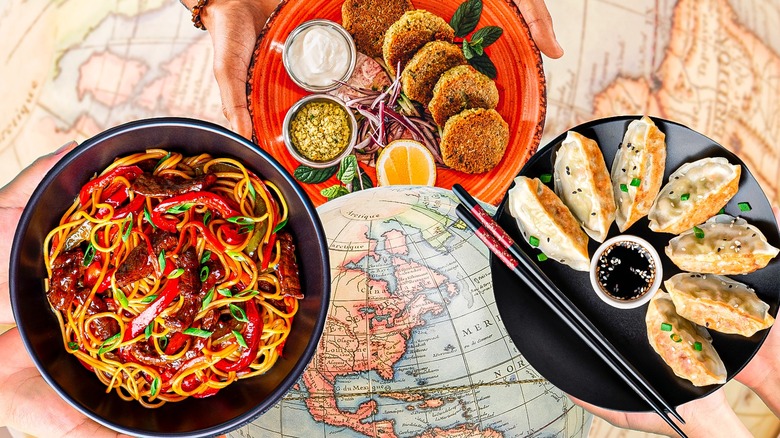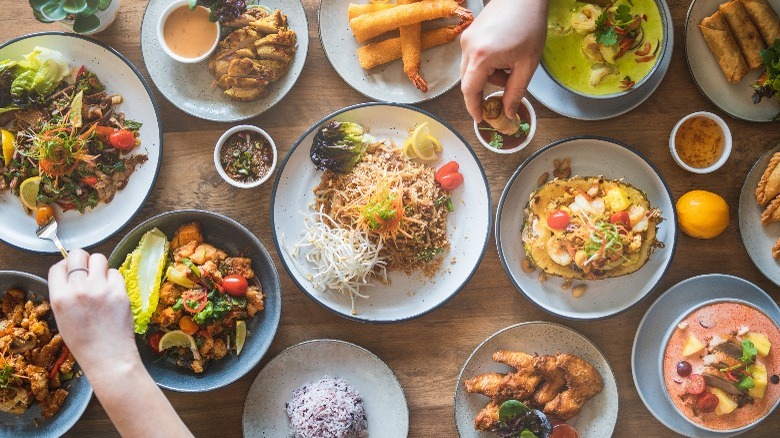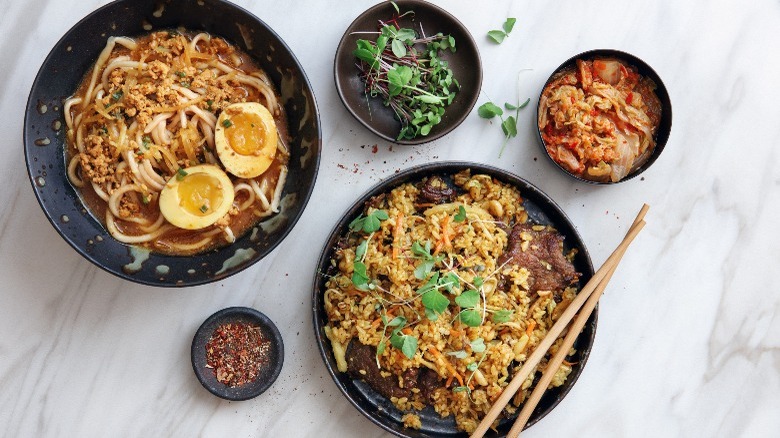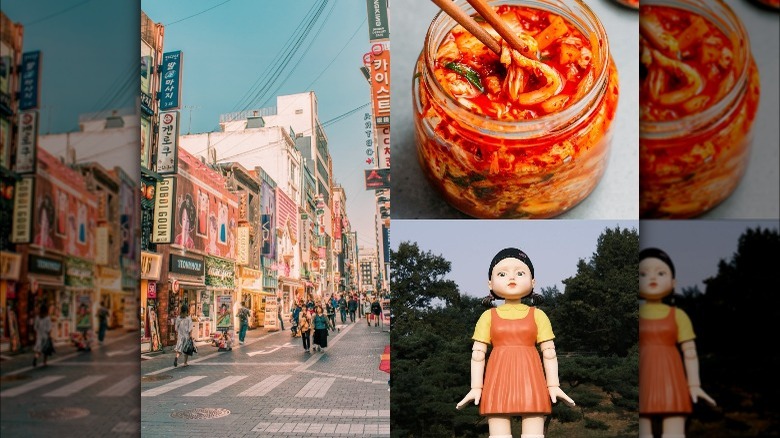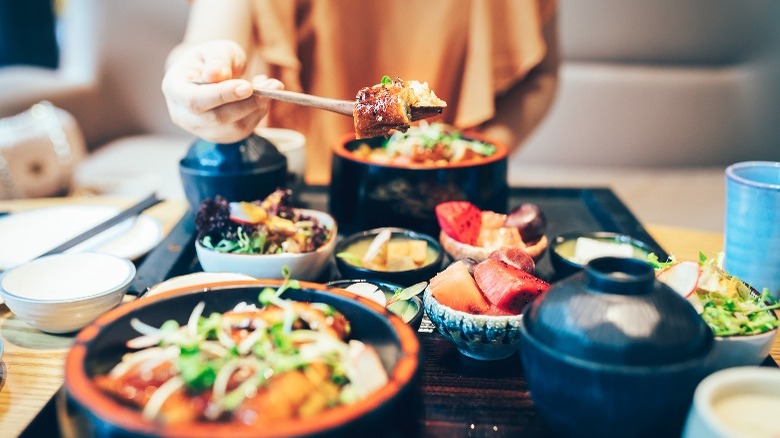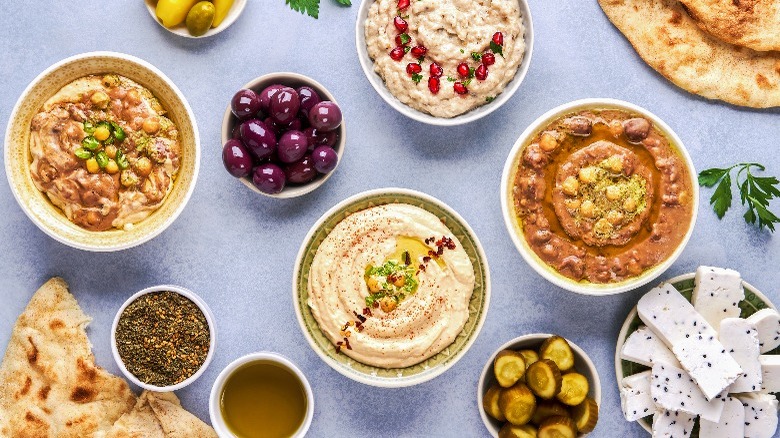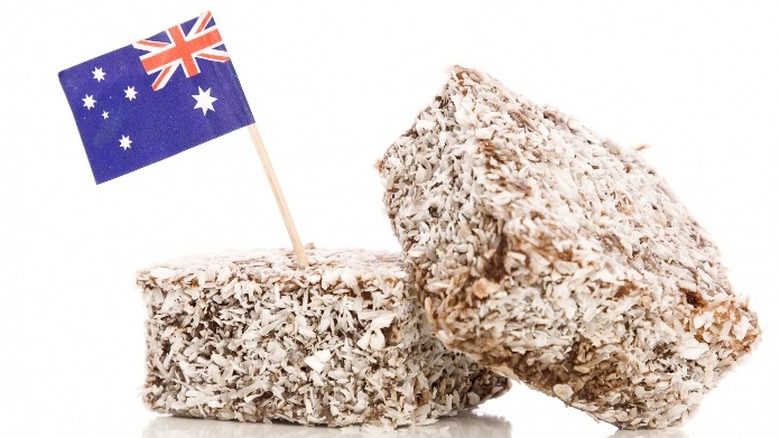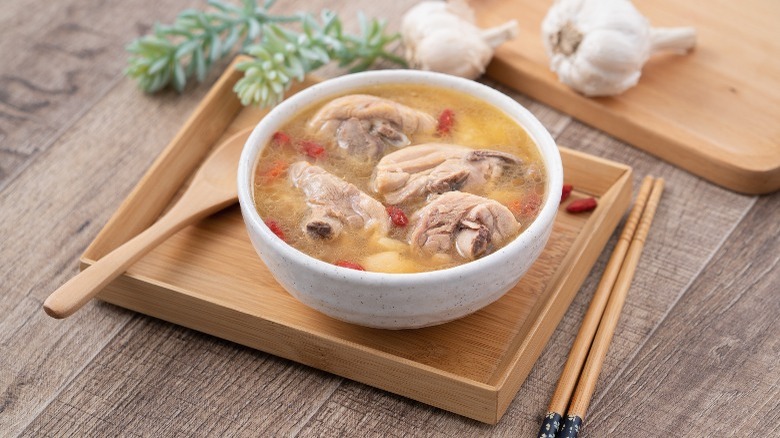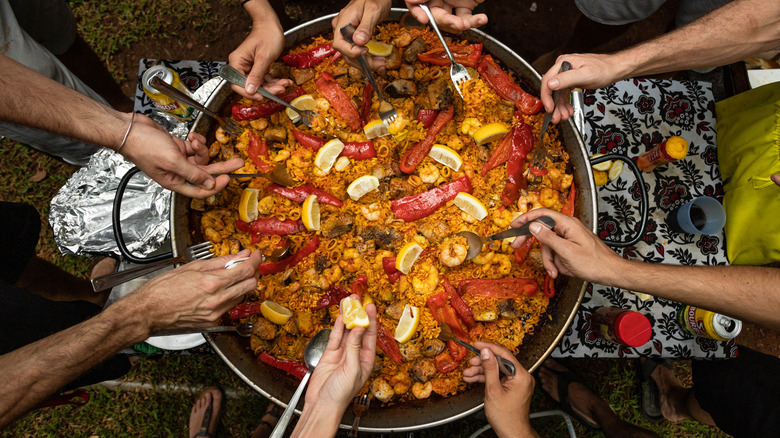For Better Or For Worse, Gastrodiplomacy Is Changing The Way We Eat
Though it may not be a concept everyone is familiar with, there's no denying the importance of gastrodiplomacy in society. But what does the word actually mean?
Gastrodiplomacy is when a country's government attempts to use food to teach other nations about the knowledge and value their country brings to the world. Because everyone needs to eat — and most of us love food — sharing food with other nations is a "soft" way to exert power and influence over others, and can be used strategically to form diplomatic relations, resolve issues, and more.
Many countries around the world have launched gastrodiplomacy initiatives, and we'll take a look at a few of the most successful ones, dive into the history of gastrodiplomacy, and look at how it can affect international relations, for better and for worse. There are times when attempts at gastrodiplomacy have gone wrong — so we'll look at what happens when initiatives don't go to plan, too.
When was gastrodiplomacy invented?
The term gastrodiplomacy was first coined in 2002 by The Economist. Don't be fooled by the modern invention of the term, though, as the roots of gastrodiplomacy can be tracked back thousands of years.
Gastrodiplomacy was likely first used in Ancient Rome and Greece. Nations invited their adversaries to dinner to consume their food, imbibe their wine, and discuss the issues of the day. This was the way allies were forged, and nations attempted to resolve their disputes without the need for war.
Fast forward to today and things haven't changed much. Though most gastrodiplomacy initiatives nowadays are more about promoting a country's cuisine and culture to a wider audience than preventing conflict, there's no denying the power that gastrodiplomacy holds to forge and strengthen international relations. Countries literally come together over the dinner table when their leaders dine and drink together — though, as we'll see later, this doesn't always go according to plan.
How Thai food became popular worldwide
Thailand was one of the first countries in the world to launch an official gastrodiplomacy plan. The Global Thai Campaign launched in 2002 with the aim of making it easier to open Thai restaurants abroad by offering assistance with obtaining visas for chefs, help sourcing authentic Thai ingredients, and templates designed to assist with opening everything from casual street food cafes to fine dining establishments.
Did the campaign work? It's safe to say that it did, as Pad Thai is available almost everywhere you look now. There are also more Thai restaurants than ever before — in 2002, there were around 5,000 Thai restaurants worldwide, and today there are over 15,000.
From Pad Thai and Thai Green Curry to Tom Kha Gai (coconut chicken soup) and Pad Kra Pao Moo (stir-fried minced pork with Thai basil and chili), you'll find Thai food on offer across any major city. Street food stalls and trucks, cozy cafes serving up authentic home-cooked Thai cuisine, and high-end Thai restaurants where you can dine on multi-course banquets are everywhere, and it's all due to the Global Thai Campaign, though you may never have realized it.
The rise of South Korean cuisine
South Korea is the birthplace of big brands like Samsung and Hyundai, but many people wrongly connect these brands with Japan, leaving South Korea out in the cold. However, President Lee Myung-bak's gastrodiplomacy plan to reach 15th place on the Anholt-GFK Roper Nation Brands Index 2013 put the country firmly on the global map.
The $40 million campaign set out to expand South Korea's culinary footprint, and it did so in several different ways, including increasing seafood and agricultural exports to other countries and increasing the number of Korean restaurants overseas. It's clear to see that the plan was a success, as in 2009, there were 1,045 South Korean restaurants in the U.S., a number that had risen to 2,247 by 2017.
The other marker of success is just how available South Korean food is in the U.S., and it's safe to say that you can readily find it in most major cities — and some smaller cities, too. Many of us now count dishes like Bibimbap (mixed rice with meat and vegetables), Bulgogi (Korean BBQ beef), Kimchi-jjigae (kimchi stew), Kimchi, and Korean fried chicken among some of our favorite South Korean dishes.
Kimchi, South Korean culture, and Squid Game
South Korea also registered several foods with the Codex Alimentarius Commission in 2009. The Commission oversees guidelines and safety standards for listed foods and can help increase global knowledge of them. To date, South Korea has six Codex standards.
It seems like 2009 was also a big year for Kimchi, as it's the year the World Institute of Kimchi was created. Its aim? To drive industry growth and establish South Korea as the birthplace of Kimchi. Given the now-global popularity of this spicy Korean specialty, it looks like the Institute's doing a great job — and in 2013, UNESCO added kimjang, the practice of making and sharing kimchi, to its List of Intangible Heritage.
As South Korean cuisine spread around the globe, the country's culture was also growing in popularity worldwide. Who could forget the 2012 hit song "Gangnam Style" or the 2020 movie "Parasite?" Korean beauty products and skincare took the world by storm, and Netflix aired its survival drama series "Squid Game" in 2021, which became the most-watched show Netflix has ever produced, with 1.65 billion hours viewed in the show's first 28 days.
Japan makes its mark on the world food map
Japan was once known only for its sushi, but today the number of Japanese restaurants in the world is on the rise. In 2006, there were only 24,000 Japanese restaurants globally — by 2017, this had risen to over 117,000. It's the aim of the Japanese government to make washoku – Japanese traditional cuisine – popular around the world.
In 2006, "Washoku – Try Japan's Good Food" campaign launched, introducing traditional Japanese dishes at events run by Japanese diplomatic missions around the globe. In 2014, UNESCO included washoku in its List of Intangible Cultural Heritage, and in 2015 at the World Expo in Milan, the Japan Pavilion saw 2.28 million guests visit to witness Japanese cooking techniques and dining habits as well as sample authentic Japanese cuisine.
Today we're used to seeing Japanese ramen and sushi bars, dumpling cafes, and restaurants around every corner in major cities. From the warming umami flavors of a hearty bowl of miso ramen to the delicate taste of Nigiri sushi and undeniably moreish steamed gyoza, Japanese food is taking the world by storm.
Tasty Lebanon launches Lebanese food worldwide
Lebanon may not be the first destination you think of for a foodie vacation, but in 2018, National Geographic earmarked the country as a must-visit destination for foodies. According to Hospitality News, that same year, the government launched its first gastrodiplomatic initiative, "Tasty Lebanon," to boost tourism, raise awareness of Lebanese brands, and increase trade and investment by exporting locally produced products worldwide.
The initiative set out many strategies to achieve its goals, including an exchange program between Lebanese culinary schools and those abroad, enabling student chefs to discover the country's ingredients for themselves. It also awarded Lebanese restaurants abroad meeting specific criteria a badge of authenticity and listed these in a booklet available to the public at Lebanese embassies. Finally, Lebanese Food Week, held in countries with Lebanese embassies, showcased authentic products and ingredients for purchase.
If you think you've never tried Lebanese food before, the chances are that you have without realizing it. Popular dishes like Tabbouleh (bulghur wheat salad) and Baba Ghanoush (smoky aubergine dip) can be found in dedicated Lebanese restaurants but also in many more general Middle Eastern establishments too. Then there are the slightly more obscure dishes that you'll need to visit major cities to enjoy, from Sfiha (open-faced meat pie) to Kibbeh (fried minced meat and bulghur wheat balls).
Australia invites the world to dinner
Australia is another country that you might not have realized has taken steps to place itself firmly on the global food map. In 2014, the Australian Ministry of Tourism launched the "There's Nothing Like Australia" campaign at a cost of $10 million.
This initiative included the "Restaurant Australia" gastrodiplomacy scheme, which targeted 12 international markets. It aimed to encourage Australians to share stories on social media about the country's food and also organized for 80 international influencers to take a foodie tour of the country. Their experiences were shared widely on social media, and the tour ended with a meal for 250 guests, "Invite the World to Dinner."
You'd be forgiven for wondering what authentic Australian cuisine looks like, though. When we think of Australia, barbecue food comes to mind, but there are more authentic dishes out there that the country likes to call its own, too. Emu — native to Australia — is often served in pies or as a pizza topping, grilled kangaroo is a local delicacy, and don't forget the country's sweet treats like Tim Tams, Lamingtons (Australia's national cake), and Anzac Biscuits.
Taiwan's Dim Sum Diplomacy
Taiwan launched its gastrodiplomacy push in 2010 with the "All in Good Taste: Savor the Flavors of Taiwan" program. Known colloquially as "Dim Sum Diplomacy," the program cost $24.2 million over its four-year run, raising awareness of Taiwan's culture, commercial products, and food.
This included substantial investment in a Taiwanese food foundation to promote Taiwanese restaurants and authentic ingredients internationally, as well as sending talented local chefs overseas to culinary schools and events. Competitions, food festivals, and cookery demonstrations around the globe introduced other countries to the delights of Taiwanese cooking and culture.
In the U.S., Taiwanese food has often fallen under the more general category of Chinese cuisine, but times are changing. In 2018, Richard Ho opened Ho Foods in NYC's East Village. Serving up beef noodle soup from his tiny storefront, Ho never expected it to become a community center for Taiwanese food in the city.
Across the U.S., chefs are transforming Taiwanese cuisine by making basics like dumpling wrappers from scratch, serving up traditional dishes with authentic ingredients, and transforming classics for a modern audience. Popular dishes nowadays include everything from Gua Bao (steamed buns filled with braised pork belly), lu rou fan (minced pork with rice), and scallion pancakes to mango shaved ice and bubble tea — the latter of which has taken the U.S. and the global market by storm.
General Franco declares Paella a Spanish national icon
When we think of Spanish food, we think of dishes like paella, churros, gazpacho, and a range of tapas. But it wasn't always this way. During Spain's dictatorship regime from 1936 to 1975, General Franco chose paella, one of his favorite dishes, as Spain's national icon. Today the dish is on the menu of almost every Spanish restaurant around the globe.
The campaign "Eat Spain Up!" was launched in 2014 to promote Spain's food, cooking techniques, and culture around the world. Initiatives included masterclasses for professional chefs and culinary students, exhibitions, discussions, and film and documentary screenings about Spanish food. One such event in Washington, D.C., involved a panel discussion and Jamon tasting.
Many Spanish dishes like paella and churros have been incorporated into everyday life in the U.S., and you'll frequently hear people refer to an array of small, shared dishes as tapas, even if the food in question isn't authentically Spanish in origin.
How gastrodiplomacy affects international relations
Promoting a country's cuisine on a global scale is the main aim of gastrodiplomacy, but let's not forget the effect that campaigns like this can have on international relations. We all need to eat, and most self-proclaimed foodies love discovering new foods to try, so sharing dinner can be an experience that brings countries together — or divides them.
You only need to look at some examples from history to realize the power of gastrodiplomacy. Nixon's 1972 visit to China put Chinese food firmly on the U.S. menu, while when Queen Elizabeth II took a trip to Belize in 1985, things didn't go quite so well over dinner.
Ensuring you've done your homework and have adequate knowledge of a country's customs and culture is a must if you're to launch a successful gastrodiplomacy plan. This was never so evident as during the faux-pas of 2018 when shoes — an item surrounded by rules and superstitions in Japanese culture — were introduced during a dinner with the Japanese prime minister.
Nixon's Chopstick Diplomacy and the rise of Chinese food in the U.S.
In 1972, then-president Richard Nixon took a trip to China that led to a huge rise in the popularity of Chinese food in the U.S. Before the trip, the president's diplomatic team received many briefings about food.
According to the International Wine & Food Society, one such briefing recommended Nixon use dinner to stroke the ego of Chinese people: "They react with much pleasure to compliments about the truly remarkable variety of tastes, textures, and aromas in Chinese cuisine." Before setting off, Nixon spent much time studying Chinese customs and learning how to use chopsticks.
On his arrival in the country, Nixon was invited to an elaborate banquet for almost 600 guests. Each guest received their own personally-inscribed chopsticks. On the menu were delights such as shark fin soup, dumplings, three-colored eggs, and sliced duck.
Anyone reading the newspapers around the time of the trip will remember the famous close-up shot of Nixon clinking glasses with guests and using chopsticks for dining. Upon seeing this shot, most Americans were convinced the visit was a success. But it was the days and months after that showed just how successful this visit had really been. In the months following Nixon's trip, Chinese restaurants across the U.S. were packed. People flocked to eateries asking for Peking duck and other authentic Chinese dishes like the ones they had seen Nixon eating.
Israel offends the Japanese prime minister with dessert in a shoe
Earlier, we mentioned how important awareness of a country's culture and customs is when launching a gastrodiplomacy initiative — or simply when inviting guests of honor from another country to dinner. This was never so evident as during a 2018 dinner with Japanese Prime Minister Shinzo Abe, Israeli Prime Minister Benjamin Netanyahu, and their wives.
The meal ended in disaster when dessert, prepared by an Israeli celebrity chef, arrived served in a shoe. As Japanese culture "despises" shoes, insisting they're taken off before entering a home or workplace, this was a huge cultural faux-pas.
Not only is it pretty strange to serve dessert out of a shoe — and we've no idea what the chef and his team were thinking — but it's also particularly insensitive to Japanese culture and customs. The result was an uproar, with everyone from the media to Japanese diplomats commenting on just how awful the decision was. One Japanese diplomat even commented on the fact that shoes are not placed on the table in any culture, highlighting just how odd the chef's choice was.
Queen Elizabeth II served rat during Belize dinner
One of the most memorable gastrodiplomacy errors of recent years took place in 1985 when Queen Elizabeth II of the U.K. visited Belize shortly after the country gained independence from Britain in 1981. During a meal in her honor, the queen was served roasted gibnut, a local nocturnal rodent considered a delicacy in the country.
Ever diplomatic, the Queen praised the chef, but tabloid newspapers in the U.K. had a field day, with headlines proclaiming the Queen had been fed "rat." Of course, this wasn't particularly sensitive to Belizean customs and culture, and many Belizeans accused the British press of insensitivity and racism.
There is a happy ending of sorts to this tale, though. Following the disastrous dinner, the gibnut became more popular and took on greater symbolic meaning in Belize. Sadly, we can't say the same for its popularity around the world.
